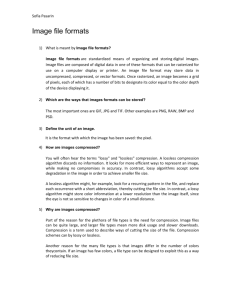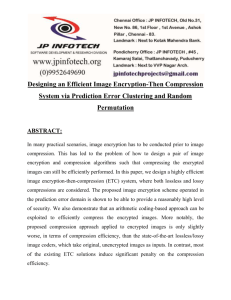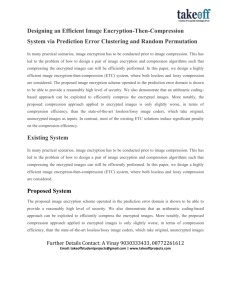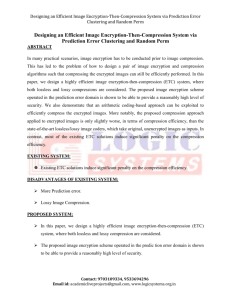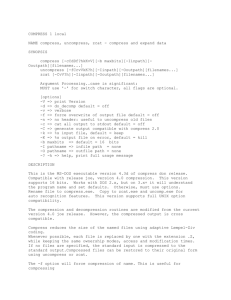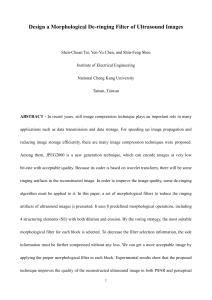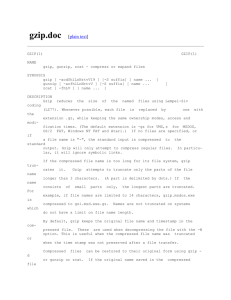Introduction
advertisement
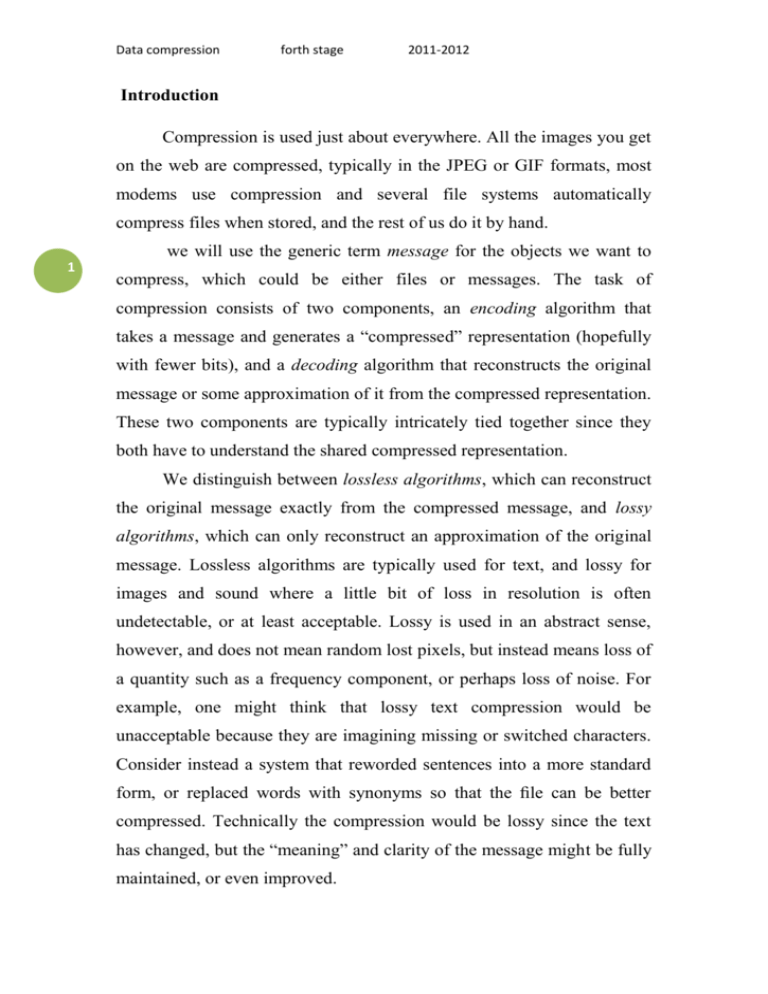
Data compression
forth stage
2011-2012
Introduction
Compression is used just about everywhere. All the images you get
on the web are compressed, typically in the JPEG or GIF formats, most
modems use compression and several file systems automatically
compress files when stored, and the rest of us do it by hand.
we will use the generic term message for the objects we want to
1
compress, which could be either files or messages. The task of
compression consists of two components, an encoding algorithm that
takes a message and generates a “compressed” representation (hopefully
with fewer bits), and a decoding algorithm that reconstructs the original
message or some approximation of it from the compressed representation.
These two components are typically intricately tied together since they
both have to understand the shared compressed representation.
We distinguish between lossless algorithms, which can reconstruct
the original message exactly from the compressed message, and lossy
algorithms, which can only reconstruct an approximation of the original
message. Lossless algorithms are typically used for text, and lossy for
images and sound where a little bit of loss in resolution is often
undetectable, or at least acceptable. Lossy is used in an abstract sense,
however, and does not mean random lost pixels, but instead means loss of
a quantity such as a frequency component, or perhaps loss of noise. For
example, one might think that lossy text compression would be
unacceptable because they are imagining missing or switched characters.
Consider instead a system that reworded sentences into a more standard
form, or replaced words with synonyms so that the file can be better
compressed. Technically the compression would be lossy since the text
has changed, but the “meaning” and clarity of the message might be fully
maintained, or even improved.
Data compression
forth stage
2011-2012
Because one can’t hope to compress everything, all compression
algorithms must assume that there is some bias on the input messages so
that some inputs are more likely than others, i.e. that there is some
unbalanced probability distribution over the possible messages. Most
compression algorithms base this “bias” on the structure of the messages
– i.e., an assumption that repeated characters are more likely than random
2
characters, or that large white patches occur in “typical” images.
Compression is therefore all about probability.
When discussing compression algorithms it is important to make a
distinction between two components: the model and the coder. The model
component somehow captures the probability distribution of the messages
by knowing or discovering something about the structure of the input.
The coder component then takes advantage of the probability biases
generated in the model to generate codes. It does this by effectively
lengthening low probability messages and shortening high-probability
messages. A model, for example, might have a generic “understanding”
of human faces knowing that some “faces” are more likely than others.
The coder would then be able to send shorter messages for objects that
look like faces. This could work well for compressing teleconference
calls.
Another question about compression algorithms is how does one
judge the quality of one versus another. In the case of lossless
compression there are several criteria I can think of, the time to compress,
the time to reconstruct, the size of the compressed messages, and the
generality. In the case of lossy compression the judgement is further
complicated since we also have to worry about how good the lossy
approximation is. There are typically tradeoffs between the amount of
compression, the runtime, and the quality of the reconstruction.
Data compression
forth stage
2011-2012
Entropy
Shannon borrowed the definition of entropy from statistical physics
to capture the notion of how much information is contained in a and their
probabilities. For a set of possible messages, Shannon defined entropy as,
3
H (S )
sS
p( s) log 2
1
.
p( s)
(1)
Where p(s) is the probability of message s. The definition of Entropy is
very similar to that in statistical physics- in physics S is the set of possible
states a system can be in and p(s) is the probability the system is in state
s. We might remember that the second law of thermodynamics basically
says that the entropy of a system and its surroundings can only increase.
Getting back to messages, if we consider the individual
messages s S , Shannon defined the notion of the self information of a
message as
i( s) log 2
1
.
p( s)
(2)
This self information represents the number of bits of information
contained in it and, roughly speaking, the number of bits we should use to
send that message. The equation says that messages with higher
probability will contain less information.
The entropy is simply a weighted average of the information of
each message, and therefore the average number of bits of information in
the set of messages. Larger entropies represent more information.
Data compression
forth stage
2011-2012
Here are some examples of entropies for different probability
distributions over five messages.
p ( S ) {0.25, 0.25, 0.25, 0.125, 0.125}
H 3 0.25 log 2 4 2 0.125 log 2 8
1.5 0.75
2.25
4
p( s ) {0.75, 0.625, 0.625, 0.625, 0.625}
4
H 0.75 log 2 4 0.625 log 2 16
3
0.3 1
1.3

